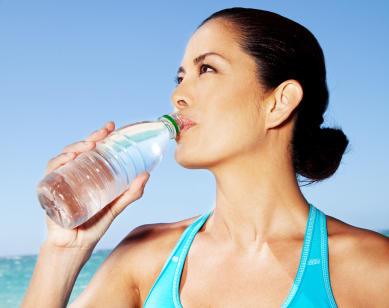

Information circulating about the dangers of plastic containers has created fear and confusion. Are plastic containers toxic? Do harmful chemicals leach out into its contents? Do we need to discard all plastic containers?
Recently, I interacted in a live health chat on MedHelp about the safety of plastics. Scientist, Joe Schwarcz, Ph.D., Director of McGill Universitya??s Office for Science and Society, talked about a??The Real Truth About Plastics: What You Should And Shouldna??t Worry About.a??
While Dr. Schwarcz states that some plastics like those made by Tupperware and Rubbermaid are safe to use, there are other plastics made of Bisphenol A (BPA) that may cause some concern, however he did not become alarmed.
There is extensive information on the safety of plastics, and reading some of it can easily cause panic and confusion, but the smartest step health consumers can do for themselves is to remain calm and dona??t become alarmed.??Gather the facts and determine whata??s best for you.
The Facts About Bisphenol A (BPA)
Bisphenol A (BPA) is used to manufacture polycarbonate plastics. This type of plastic is used to make some types of beverage containers, compact disks, plastic dinnerware, impact-resistant safety equipment, automobile parts, and toys. BPA epoxy resins are used in the protective linings of food cans, in dental sealants, and in other products.
General exposure to BPA at low levels comes from eating food or drinking water stored in containers that have BPA. Small children may be exposed by hand-to-mouth and direct oral (mouth) contact with materials containing BPA. Dental treatment with BPA-containing sealants also results in short-term exposure. In addition, workers who manufacture products that contain BPA can be exposed.
How Does BPA Get Into The Body?
BPA can leach into food from the epoxy resin lining of cans and from consumer products such as polycarbonate tableware, food storage containers, water bottles, and baby bottles. Additional traces of BPA can leach out of these products when they are heated at high temperatures.
During The Live Chat
An audience member during the live chat asked about the safety of plastics that contain chemicals that mimic estrogen that may result in developing breast, uterine, or ovarian cancers. Dr. Schwarcz replied that these plastics contain BPA and phthalates and that they are estrogenic. He states, however that we are a??exposed to estrogenic compounds all over the place. Soy contains isoflavones which are estrogenic, so do chickpeas, and of course milk!?? Natural estrogens in milk are thousands of time more potent estrogens than BPA.a??
Dr. Schwarcz writes about BPA in his blog “Chemically Speaking”:
a??The more bisphenol A is in the news, the more acrimonious and self-serving the debates seem to get.?? On one side we have some scientists stirring the pot with statements like a??The science is clear and the findings are not just scary, they are horrific.?? When you feed a baby out of a clear, hard plastic bottle, ita??s like giving the baby a birth control pill.a???? This is absurd.?? The science isna??t clear, ita??s quite murky.?? If it were all clear, we wouldna??t be having such bitter debates.a??
On the other hand, the BPA defenders, mostly with industrial connections, claim that BPA has been safely used for fifty years and presents no risk to humans.?? This is a hollow claim.?? True, nobody has ever experienced an acute reaction from traces of BPA leached out of a polycarbonate bottle, but that is not the kind of risk wea??re worried about.?? The concern is over the possibility of subtle effects that may turn up after long term exposure to minute amounts of BPA, or health problems that may be manifested in the distant future if exposure occurs at a crucial stage of development.?? Such concerns are legitimate and are based upon suggestive, but certainly not conclusive, evidence.a??
American Chemistry Council
a??An international panel of experts concluded that food is by far the main source of bisphenol A (BPA) exposure and that other sources are of minor relevance. The experts were also able to model circulating levels of BPA in the human body, which are very low, indicating that BPA is not accumulated in the body and is rapidly eliminated.a?? [Source: The World Health Organization (WHO), 2010.]
U.S. Food And Drug Administration (FDA)
But according to the U.S. Food and Drug Administration (FDA), in January 2010 the FDA announced it shares the perspective of the National Toxicology Program (NTP) that recent studies provide reason for some concern about the potential effects of BPA on the brain, behavior, and prostate gland of fetuses, infants, and children.??a??The NTP has minimal concern for effects on the mammary gland and an earlier age for puberty for females in fetuses, infants, and children at current human exposures to bisphenol A.a??
a??FDA also recognizes substantial uncertainties with respect to the overall interpretation of these studies and their potential implications for human health effects of BPA exposure.?? These uncertainties relate to issues such as the routes of exposure employed, the lack of consistency among some of the measured endpoints or results between studies, the relevance of some animal models to human health, differences in the metabolism (and detoxification) of and responses to BPA both at different ages and in different species, and limited or absent dose response information for some studies.
FDA is pursuing additional studies to address the uncertainties in the findings, seeking public input and input from other expert agencies, and supporting a shift to a more robust regulatory framework for oversight of BPA to be able to respond quickly, if necessary, to protect the public.a??
Information from the live chat provided by Dr. Schwarcz and audience questions appear below. You can read the full health chat on the safety of plastics on MedHelp.
The Real Truth About Plastics: What You Should And Shouldna??t Worry About
Q:?? Barbara
Are plastics safe to store food???Is there a difference between the containers bought in a dollar store as opposed to higher price plastic containers?
A: Dr. Schwarcz
There are many types of plastic containers.??The ones sold for storage like Tupperware and Rubbermaid (I have no association with either of those companies) are great, they are made of polyethylene or polypropylene.??I wouldna??t, however, heat up tomato sauce in an old margarine tub because that has only been tested for margarine storage.??As a general rule though for use in the microwave, oven glass or ceramic are the best.
Q:?? Katscan
Some vegetables come in those microwave bags. Are they safe to use? What about storing food in Ziploc bags? I do that all the time. Am I exposing myself to BPA?
A:?? Dr. Schwarcz
Not a molecule of BPA in sight.??These are made of polyethylene, the same as the shopping bags, hula hoops, etc.
Q:?? SixUntilMe
Is it safer to use plastic or glass bottles for a newborn???I hear conflicting reports, and as a new mom Ia??m paranoid.
A:?? Dr. Schwarcz
As you may have heard, Canada as well as some European countries and several states in the U.S.??have banned polycarbonate #7 baby bottles because of developmental problem concerns.??This is based on the a??precautionary principlea?? which suggests that if there is any risk we should avoid the substance, but one also has to exercise the precautionary principle in exercising the precautionary principle meaning that you have to make sure that the replacement is less risky than what you are replacing.??I think in the baby bottle business, we have glass which is certainly a good replacement.
Bottom Line
Dr. Schwarcz talks about the a??precautionary principlea?? where using a replacement that is less risky is good option like in the case of baby bottles.??Glass bottles are available and it is a good alternative to plastic ones.??He also says that using a??glass or ceramica?? are the best in the microwave.??He did not say to stop drinking out of water bottles and buy only BPA-free products either.??He did say in his live chat that plastics that mimic estrogen contain BPA.??He further adds that we are a??exposed to estrogenic compounds all over the place,a?? milk, soy, chickpeas are some examples of these compounds. a??Natural estrogens in milk are thousands of time more potent estrogens than BPA,a?? he stated during the live chat.
While there is no clear conclusive evidence that BPA is 100 percent detrimental to your health, there is a report from the FDA in conjunction with the National Toxicology Program (NTP) that recent studies provide reason for some concern about the potential effects of BPA on the brain, behavior, and prostate gland of fetuses, infants, and children.??The NTP has minimal concern for effects on the mammary gland and an earlier age for puberty for females in fetuses, infants, and children at current human exposures to bisphenol A.
What Can You Do To Prevent Exposure To BPA?
If you’re concerned, you can make personal choices to reduce exposure:
- Dona??t microwave polycarbonate plastic food containers. Polycarbonate is strong and durable, but over time it may break down from repeated use at high temperatures.
- Avoid plastic containers with the #7 on the bottom.
- Dona??t wash polycarbonate plastic containers in the dishwasher with harsh detergents.
- Reduce your use of canned foods. Eat fresh or frozen foods.
- When possible, opt for glass, porcelain, or stainless steel containers, particularly for hot food or liquids.
- Use infant formula bottles that are BPA-free and look for toys that are labeled BPA-free.
You are smart health consumers. You can decide whata??s best for you.
Additional Resources
U.S. Food and Drug Administration (FDA)
National Toxicology Program Bisphenol A (BPA) Fact Sheet
National Toxicology Program (BPA)
National Toxicology Program??(headquartered at the National Institute of Environmental Health Sciences, NIH-HHS)
Chemically Speaking
The Harvard Medical School Family Health Guide
U.S. Department of Health and Human Services
U.S. Food and Drug Administration (Homepage)
Centers for Disease Control and Prevention
U.S. Environmental Protection Agency
Consumer Product Safety Commission
National Institute of Environmental Health Sciences
Your Turn
We would love to hear your insightful thoughts.??Are you concerned about the safety of plastics???Do you use plastic containers???Do you use only glass containers???Are you concerned about the BPA? Do you buy BPA free products???What type of containers do you use to microwave your foods?
As always, thank you for your time.

u


 We’ve all been there. It often starts with some kind of recurring pain or dull ache. We dona??t know whata??s causing the pain or ache. During the light of day we tell ourselves that it’s nothing. But at 3:00am when the pain wakes you, worry sets in: “Maybe I have cancer or heart disease or some other life-ending ailment.” The next day you make an appointment to see your doctor.
We’ve all been there. It often starts with some kind of recurring pain or dull ache. We dona??t know whata??s causing the pain or ache. During the light of day we tell ourselves that it’s nothing. But at 3:00am when the pain wakes you, worry sets in: “Maybe I have cancer or heart disease or some other life-ending ailment.” The next day you make an appointment to see your doctor.

 Barbara Okun, Ph.D., is a professor of counseling psychology at Northeastern University, a clinical instructor at Harvard Medical School, and a clinical psychologist and family therapist. Joseph Nowinski, Ph.D., is a nationally known psychologist with more than 20 years experience working with individuals and families. Their new book, Saying Goodbye: How Families Can Find Renewal Through Loss, has just been published.
Barbara Okun, Ph.D., is a professor of counseling psychology at Northeastern University, a clinical instructor at Harvard Medical School, and a clinical psychologist and family therapist. Joseph Nowinski, Ph.D., is a nationally known psychologist with more than 20 years experience working with individuals and families. Their new book, Saying Goodbye: How Families Can Find Renewal Through Loss, has just been published.
 The February issue of Prevention magazine has an article entitled “Surprising Faces of Heart Attack” profiling “three women (who) didn’t think they were at high risk. Their stories are proof that you could be in danger without even knowing it.” No, their stories are not proof of that.
The February issue of Prevention magazine has an article entitled “Surprising Faces of Heart Attack” profiling “three women (who) didn’t think they were at high risk. Their stories are proof that you could be in danger without even knowing it.” No, their stories are not proof of that. I asked one of our HealthNewsReview.org medical editors, Harold Demonaco, director of the Innovation Support Center at the Massachusetts General Hospital, to review the two pieces. As his day-job title suggests, he deals??with review of the evidence for new and emerging healthcare technologies. He wrote:??
I asked one of our HealthNewsReview.org medical editors, Harold Demonaco, director of the Innovation Support Center at the Massachusetts General Hospital, to review the two pieces. As his day-job title suggests, he deals??with review of the evidence for new and emerging healthcare technologies. He wrote:??
 a??This job is killing mea?? is not a statement of jest. It is a desperate plea of outright sincerity.
a??This job is killing mea?? is not a statement of jest. It is a desperate plea of outright sincerity.



 Guest post submitted by MD Anderson Cancer Center*
Guest post submitted by MD Anderson Cancer Center* A patient reading a copy of Prevention in the waiting room brought to my attention an interesting article entitled a??7 Foods That Should Never Cross Your Plate.a?? I would have to agree that these seven commonly eaten foods should be avoided, so Ia??ll rehash them here, along with??three more of my own choosing to flesh out a New Yeara??s 7 + 3 = Top 10 list.
A patient reading a copy of Prevention in the waiting room brought to my attention an interesting article entitled a??7 Foods That Should Never Cross Your Plate.a?? I would have to agree that these seven commonly eaten foods should be avoided, so Ia??ll rehash them here, along with??three more of my own choosing to flesh out a New Yeara??s 7 + 3 = Top 10 list.

 This is a guest post by Dr. Jeremy Windsor.
This is a guest post by Dr. Jeremy Windsor. Jeremy Windsor,??MD??is currently a Specialist Registrar in Anaesthetics rotating through hospitals in north London. He is Editor of the??High Altitude section??of Wilderness??& Environmental Medicine and one of two UK representatives on the UIAA Medical Commission.
Jeremy Windsor,??MD??is currently a Specialist Registrar in Anaesthetics rotating through hospitals in north London. He is Editor of the??High Altitude section??of Wilderness??& Environmental Medicine and one of two UK representatives on the UIAA Medical Commission.




 Birth defects,??particularly those of the blood vessels, account for the majority of infant deaths, especially after the first week of life. Congenital heart disease (CHD) — meaning defects of the heart –??is responsible for one-third of deaths between birth and the first year of life. Therefore, the diagnosis of CHD is critical in order to plan life-saving treatments, such as the proper place for the delivery, the type of delivery, and its timing. If it’s known in advance that an unborn baby has a heart problem and is delivered in a hospital that provides special care, its survival and future
Birth defects,??particularly those of the blood vessels, account for the majority of infant deaths, especially after the first week of life. Congenital heart disease (CHD) — meaning defects of the heart –??is responsible for one-third of deaths between birth and the first year of life. Therefore, the diagnosis of CHD is critical in order to plan life-saving treatments, such as the proper place for the delivery, the type of delivery, and its timing. If it’s known in advance that an unborn baby has a heart problem and is delivered in a hospital that provides special care, its survival and future